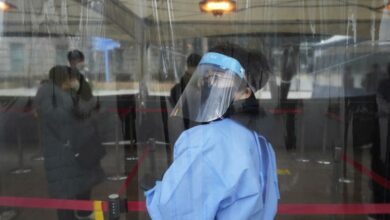For me, El-Hanager Arts Center was more than just a theater or a place for art exhibitions. awarded the best It was a veritable artistic academy that emboldened the dreams of the artists of tomorrow. "Today it is a pile of rubble," laments director Hani El-Metnawi
In 1989, El-Hanager attracted university students who formed independent theater troupes, part of the independent theater movement at the time. When Cairo International Experimental Theater Festival was called off in 1990 due to the Gulf War, performances by international troupes were replaced with those by the free theater troupe. It was El-Hanager that opened its arms to those young performers and nurtured their talents through workshops. Those acting, directing, scenography, and dramaturgy classes were delivered by some of the most gifted theater artists around.
I attended El-Hanager in those days. We used to have the workshops during the day and then rehearsals in the evening. El-Hanager was our academy and cultural club. We would spend hours on end in El-Hanager’s cafeteria, which brought together people from theater and cinema, as well as musicians and politicians of every stripe from Egypt, other Arab countries, and around the world.
In one corner of the cafeteria stood a library where you could read a book while enjoying your coffee. We once met Peter Brook, one of the most celebrated theater directors in the world, and exchanged ideas with him at a seminar attended by the stars of Egyptian theater.
At El-Hanager Theater, we were trained by the most prominent theater directors in Egypt and the world: Qassem Mohamed, Rogé Assaf, Jawad el-Assadi, Awni Kromi, Ragaa ben Ammar, Nour el-Sherif, Samir el-Asfouri, Eva-Maria Lerchenberg-Thöny, Bruno Massé, and several others.
Artists were trained in various acting techniques: grotesque acting, the art of clowning, elastic theater, dance acting, and many more. El-Hanager dispatched its artists overseas to gain valuable experience as directors, actors, or technicians.
Such training wasn’t provided anywhere in Africa except at the Theatrical Arts Institute. El-Hanager produced a new generation of artists. Its performances very often sold out. El-Hanager’s talented artists represented Egypt, the Middle East and Africa in festivals the world over, and world artists proudly performed on its stage. El-Hanager became a cultural and artistic institution in the region, and a dream for every Egyptian who hoped to get on stage some day.
Then the American army invaded Iraq. Several performances in the second session of the Cairo International Experimental Theater Festival tackled the issue of the war and questioned its suitability as a solution. Meanwhile, the government increased the presence of security forces in the cafeteria and auditoriums and we were questioned daily.
Then came in the news that El-Hanager was going to be renovated. We were bewildered because El-Hanager wasn’t in need of renovation. "This is a conspiracy to close down El-Hanager," said Saad Ardash, one of the pioneers of Egyptian theater.
The decision was abrupt and no one explained the plan for renovation. In grave doubt, we communicated our fears to Huda Wasfy, our mentor, but she didn’t seem to imagine anything of the sort was possible. How could that be the response to the perfect cultural and artistic institution she had created, one that inspired admiration from countries like France and Spain?
Then El-Hanager was suddenly invaded by men carrying axes. With the blow of an axe, the stage was flattened beyond repair– apparently not for renovation purposes. It was an attempt to reduce the once lively stage into a ghostly ruin.
In three days, the dream was shattered. The renovations were never carried out, ostensibly because there seemed to be a link between the arrest of the Director of the Cultural Development Fund and the renovation of El-Hanager. That mysterious link meant that El-Hanager would remain a heap of rubble.
Today, El-Hanager is a big parking lot for the Central Security trucks, the posh cars of football stars, and police patrol cars.
El-Hanager theater had seen an amazing amalgam of budding and celebrated stars performing together. That theater presented the last play of innovative director Karam Metawea, "Diwan el-Baqar" (The Diwan of Cows), drawing an audience so big that some were forced to watch the play standing.
Many young directors followed in Metawea’s footsteps, their experiments culminating in the unique play "Fedra Sayyedat el-Asrar" (Fedra, the Woman of Secrets). The play was applauded by the world’s creative artists who were in Cairo for the Experimental Theater Festival.
El-Hanager also presented a play titled "El-Leab fel Demagh" (Playing in Your Head), which achieved unprecedented success. Tickets being sold out for four whole months, at a time when other theaters were almost empty.
El-Hanager is where different generations met and together produced several important artistic experiments. The artists of El-Hanager are now the stars of Egyptian cinema, and members of theaters troupes in Africa, Asia, Europe, and Latin America.
Rumors are circulating that the Director of the Cultural Development Fund was under surveillance and that when enough evidence had been gathered to indict him, the decision to arrest him was postponed for three days–the time needed to send the workers to tear down the theater and have the director imprisoned on trumped-up charges. Once he was arrested, a contractor became involved in the case, ensuring that it would linger in the courts for years.
Meanwhile, everything stays as it is until the case is settled. That way, it will seem like some series of mysterious mishaps, brought about by fate alone, are responsible for the demolition of El-Hanager. But if the demolition of the theater was an act of fate, then why isn’t it being rebuilt? Is it an attempt to undermine El-Hanager’s cultural role? Perhaps. But why?
The answers are out there, but we are still waiting.




